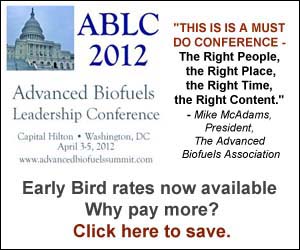U.S AMASSeco: Lab of Google or Hoax!Supporting Biofuels Prices without Taxes or Subsidies – a Biofuels Digest special report
 For
some time, the Digest has encouraged the biofuels industry to “Get off
the dope,” and dismantle the ineffective web of subsidies and tariffs
with which it is ineffectively, expensively, and infamously protected —
replacing them with a new schedule of research grants, loan guarantees
and mandates that incentivize the production of biofuels that are
superior on emissions, environment, and economics.
For
some time, the Digest has encouraged the biofuels industry to “Get off
the dope,” and dismantle the ineffective web of subsidies and tariffs
with which it is ineffectively, expensively, and infamously protected —
replacing them with a new schedule of research grants, loan guarantees
and mandates that incentivize the production of biofuels that are
superior on emissions, environment, and economics.“Fight an idea with a better idea,” is our motto, and today we present an overview by Digest special correspondent Tim Sklar, “Supporting Biofuels Prices without Taxes or Subsidies,” which examines existing support programs and proposes alternatives which offer a more affordable, equitable means of achieving the transition to renewable fuels.
By Tim Sklar, Biofuels Digest special correspondent
Overview
As addressed in many articles that have appeared in this magazine and in other publications reporting on the renewable energy industry, one of the major impediments to increasing the production and use of biofuels is the difficulty in financing even the most promising of biofuels processing plant projects. Biofuels project developers not only have to find ways to mitigate the technical risks of such projects, and the business risk associated with financing, managing and operating start-up enterprises.
They must often confront the prospect that the biofuels prices they require, may not provide adequate rates of return to their investors. Because biofuels now compete directly against the conventional fuels they are designed to replace, prices received often prove inadequate, as the costs of producing and distributing biofuels are often higher and depend on other factors.
As a consequence, adequate margins over the life of a biofuels project cannot be assured, making many of these projects too risky for obtaining conventional financing.
In the past, government has tried to subsidize biofuels prices, in order to make them comparable to prices being obtained for conventional fuels. In addition, government backed grants; loans and loan guarantees have been offered to biofuels project developers, where conventional financing has not been available.
But in spite of these government initiatives, the prospects for financing biofuels projects remains impaired.
As a consequence there is renewed interest in imposing special taxes on gasoline and other motor fuels and using the tax proceeds to establish and maintain “trust funds” for financing biofuels project development. There is also renewed interest in using carbon taxes to make it more expensive to use fossil fuels of all types, which proponents believe would increase the prices renewable fuels could command.
Being overlooked are schemes that do not impose new taxes on industry or the individual taxpayer, or create inflationary pressure on the economy. Described in this article is one such scheme that did just that. Known as “The Old Oil Entitlements Program”, this scheme had been used from 1974 to 1981, the period in which price controls had been imposed on refined products sold in the US and on crude oil produced in the US. This scheme succeeded in equalizing the cost of refined products among US refiners and resellers This article highlights how this was done, how a similar program could be designed to equalize the economic impact on blenders of biofuels, without the use of taxes, subsidies or biofuels floor price mandates.
Blenders’ Tax Credits, An Imperfect Biofuels Price Subsidy
Federal Government incentives that are still being used to encourage the development and use of biofuels are the excise tax credits offered biofuels blenders, a.k.a., and “blenders’ credits”. Biofuels blenders include refiners as well as bulk distributors involved in the “first sale” of transportation fuels, who blend ethanol with gasoline or biodiesel with petroleum diesel. Although these blenders’ credits have had the effect of keeping biofuels prices comparable to prices received for petroleum based transportation fuels, while providing biofuels producers with enough additional revenue to allow them to remain in operation at a time of falling petroleum prices, it appears that blenders’ credits programs will ultimately prove to be inadequate.First, they do not provide the certainty that adequate biofuels prices can always be obtained. The obvious problem is structural, as the blenders’ credits are set by legislation as a fixed amount per gallon, and subject to change, without regard to changes in fuels market prices.
Second, blenders’ credit legislation that is passed is subject to potential revision, discontinuance or repeal, depending on the prevailing mood in the Congress. And investors in projects that rely on price floors that are propped up by blenders’ credits, have no assurance that these floors would be sustained over the project’s life.
An example of this legislative uncertainty appeared in the May 28, 2010 edition of The Biofuels Digest, in the article titled “US House of Representatives passed the American Jobs and Closing Tax Loopholes Act”. As explained in this article, assuming that this act passes The US Senate, the biodiesel tax credit is to be extended retroactively to January 1, 2010, and expire December 31, 2010. This legislation illustrates provisional nature of biofuels tax credits and the need to obtain continuous political support to insure future biofuels tax credit availability.
Periodically, tax credits of this type become unpopular, as they are viewed as a subsidy to the private sector, paid for by the US taxpayer. Further tax subsidies supporting increased use of “first generation” biofuels, such as corn ethanol, sugar based ethanol and soybean oil derived biodiesel are particularly unpopular with members of Congress who are against USDA programs supporting corn, soybeans and sugar crops.
Gasoline Taxes, A Bad Idea
July’s Car and Driver Magazine had an article that tried to stimulate interest in a gasoline tax to reduce gasoline use and encourage other options such as increased use of biofuels. The author, Aaron Robinson makes reference to a paper published by Harvard’s Dr. Gregory Mankiw in which Dr. Mankiw presents a number of arguments for a higher gasoline tax, making his case based on his economic perspectives. But Dr. Mankiw readily admits that the prospects of imposing higher gasoline taxes remain politically untenable, concluding that the prospects for this option being implemented are remote. Dr Mankiw’s paper can be downloaded from the following website:www.economics.harvard.edu/files/faculty/40_Smart%20Taxes.pdf.Carbon Taxes, A Controversial Solution
In the European Union, carbon tax regimes are already in place and have undergone adjustments and refinements. The impact on renewable energy producers has been significant, particularly among those who are supplying woody biomass in the form of chips, pellets and torrefied wood to users of coal or natural gas in generating power. In some instances, the price being paid for torrefied wood is in excess of E180 per mt, which is three to four times the price being paid for coal in the US. But if carbon taxes were imposed on coal fired power plants in the US it is argued by opponents of carbon taxes or “cap-n-trade” schemes that the resulting higher cost of fuels will be passed through in the cost of power and ultimately, will add to inflation. And as with the gasoline tax proposals, carbon tax proposal have proven to be politically untenable, and the prospects for this option being implemented is also remote and unlikely.The Old Oil Entitlements Program- Why It Was Necessary
In Phase I of the Economic Stabilization Act of 1970, price ceilings had been initially established on hundred of products and services in most sectors of the US economy. In November, 1971, Phase II commenced, lifting price controls on all sectors other than oil and gas. In January, 1973, Phase III, commenced, making oil and gas price controls voluntary. But heating oil prices spiked and a special rule was passed in March 1973 re-imposing strict price controls on 23 largest domestic refiners, that accounted for 95% of refined product sold.
The rising cost of imported oil forced these refiners to reduce their imports, causing them to reduce product sales to independent marketers and creating product shortages. Congress then passed the Emergency Petroleum Allocation Act in November 1973 creating a two-tiered price control system on domestic oil, namely “Old Oil” and “New Oil”. Old Oil was the oil produced in 1972 from existing wells and was capped at the posted prices in July 1973, which averaged ~$3.50/barrel.
New Oil was domestic oil that was being produced from properties that exceeded base production levels established in 1972. New Oil was allowed to command market prices and it initially averaged between a ~$8.50 and $11.50 per barrel. Imported oil was never subject to price controls as the US Government had no jurisdiction. Imported oil often commanded prices that exceeded the prices paid for New Oil.
During this period, the price for gasoline in the United States reflected these increased costs, thus allowing refiners who had significant access to Old Oil an opportunity to realize much larger profits than their competitors who did not. This immediately led to market distortions whereby refiners with higher crude oil costs were often not able to realize prices for fuels that their higher costs would allow, and as a consequence, many began to operate at a loss.
How It Worked
FEA then instituted The Old Oil Entitlements Program to equalize the cost of crude oil among refiners. Basically, those refiners who had the advantage of using more Old Oil as a percentage of operations than the industry average, had to buy “entitlements” from those refineries that used less than average percentage amount of Old Oil. In other words, buying “entitlements” allowed refiners to run the excess amounts of Old Oil that they had, but they had to make money transfers by paying refiners who had less than average amounts of Old Oil and had entitlements to sell.
FEA’s role was to administer this program, by matching buyers of entitlements to entitlements sellers, and overseeing the transfer of funds from buyers to sellers. The price of each entitlement reflected the difference between the system-wide average per barrel price being paid for decontrolled oil and the system-wide average per barrel price being paid for Old Oil. Over its life from 1974 to 1981 this program underwent many modifications to cope with a variety of changes and distortions that ensued.
These details are well documented in a paper titled “Economic Amnesia: The Case against Oil Price Controls…”, by Jerry Taylor and Peter Van Doren, Cato Institute, Washington, DC.
A New Program Based on An Old One That Worked- Why Not!
Old Oil Entitlement Program Logic
Exhibit 1a contains a hypothetical list of 20 refiners, their daily throughput capacity in MMBPD, average monthly crude oil processed (run to stills), and the average monthly % of old oil run, and the average domestic (price controlled Old Oil) that was processed.
| FEA Old Oil Entitlements Program | ||||
| Monthly Crude Runs | ||||
| Refiner | Total | Old Oil | Old Oil | |
| Number | MMBPD | Run to Stills | % of Total | Run to Stills |
| 1 | 300,000 | 9,090,000 | 30% | 2,727,000 |
| 2 | 270,000 | 8,181,000 | 40% | 3,272,400 |
| 3 | 243,000 | 7,362,900 | 50% | 3,681,450 |
| 4 | 218,700 | 6,626,610 | 25% | 1,656,653 |
| 5 | 196,830 | 5,963,949 | 20% | 1,192,790 |
| 6 | 177,147 | 5,367,554 | 20% | 1,073,511 |
| 7 | 159,432 | 4,830,799 | 30% | 1,449,240 |
| 8 | 143,489 | 4,347,719 | 40% | 1,739,088 |
| 9 | 129,140 | 3,912,947 | 20% | 782,589 |
| 10 | 116,226 | 3,521,652 | 10% | 352,165 |
| 11 | 104,604 | 3,169,487 | 20% | 633,897 |
| 12 | 94,143 | 2,852,538 | 30% | 855,761 |
| 13 | 84,729 | 2,567,284 | 40% | 1,026,914 |
| 14 | 76,256 | 2,310,556 | 50% | 1,155,278 |
| 15 | 68,630 | 2,079,500 | 40% | 831,800 |
| 16 | 61,767 | 1,871,550 | 30% | 561,465 |
| 17 | 55,591 | 1,684,395 | 20% | 336,879 |
| 18 | 50,032 | 1,515,956 | 10% | 151,596 |
| 19 | 45,028 | 1,364,360 | 70% | 955,052 |
| 20 | 40,526 | 1,227,924 | 90% | 1,105,132 |
| Totals | 2,635,270 | 79,848,682 | 32% | 25,540,659 |
| Crude Oil Acquisition Costs in $/bbl-1974 | 8.39 | |||
| Exhibit 1a | ||||
Exhibit 1b provides entitlements calculations for each of the 20 refiners.
- Column (a) shows he amount of Old Oil processed and the average monthly price paid for Old Oil
- Column(b) shows the amount of Decontrolled Oil processed and the average monthly price paid for Decontrolled Oil.
- Column (c) shows the amount of old oil each refiner would have run if they had acquired the system average of 32% of their runs to stills as Old Oil, and,
- Column (d) shows the number of entitlements each would have to sell or (buy) and depends on how many barrels of old oil they were short, or they received in excess of the average in which they were entitled.
The row containing information for Refiner # 3 indicates that Refiner #3 would have to buy 1,326,329 entitlements from refiners with entitlements to sell.
In other words, Refiner #1 would receive $5,104,346 in revenue from sale of its entitlements and Refiner #3 would have to spend an additional $37,495,316 in order to be able to run its excess old oil.
Further, the $28.27 entitlement price used would have been set for that month by FEA based on the difference between the $36.66/bbl average decontrolled oil price paid by all participating refiners, and the average old oil price paid of $8.39/bbl.
| FEA Old Oil Entitlements Program | |||||
| a | b | c | d | e | |
| Equalized | # Entitlements | Amount | |||
| Refiner | Old Oil | Oil at Mkt | Old Oil @ Avg= | to Sell/(Buy) | Received or (Paid) |
| No. | Run to Stills | Run to Stills | 32% | Col. c – Col. a | Col. d x E’Price |
| 1 | 2,727,000 | 6,363,000 | 2,907,557 | 180,557 | 5,104,346 |
| 2 | 3,272,400 | 4,908,600 | 2,616,801 | -655,599 | -18,533,775 |
| 3 | 3,681,450 | 3,681,450 | 2,355,121 | -1,326,329 | -37,495,316 |
| 4 | 1,656,653 | 4,969,958 | 2,119,609 | 462,957 | 13,087,782 |
| 5 | 1,192,790 | 4,771,159 | 1,907,648 | 714,858 | 20,209,046 |
| 6 | 1,073,511 | 4,294,043 | 1,716,883 | 643,373 | 18,188,141 |
| 7 | 1,449,240 | 3,381,559 | 1,545,195 | 95,955 | 2,712,659 |
| 8 | 1,739,088 | 2,608,631 | 1,390,676 | -348,412 | -9,849,608 |
| 9 | 782,589 | 3,130,358 | 1,251,608 | 469,019 | 13,259,155 |
| 10 | 352,165 | 3,169,487 | 1,126,447 | 774,282 | 21,888,950 |
| 11 | 633,897 | 2,535,590 | 1,013,802 | 379,905 | 10,739,915 |
| 12 | 855,761 | 1,996,777 | 912,422 | 56,661 | 1,601,798 |
| 13 | 1,026,914 | 1,540,371 | 821,180 | -205,734 | -5,816,095 |
| 14 | 1,155,278 | 1,155,278 | 739,062 | -416,216 | -11,766,427 |
| 15 | 831,800 | 1,247,700 | 665,156 | -166,644 | -4,711,037 |
| 16 | 561,465 | 1,310,085 | 598,640 | 37,175 | 1,050,940 |
| 17 | 336,879 | 1,347,516 | 538,776 | 201,897 | 5,707,631 |
| 18 | 151,596 | 1,364,360 | 484,899 | 333,303 | 9,422,475 |
| 19 | 955,052 | 409,308 | 436,409 | -518,643 | -14,662,051 |
| 20 | 1,105,132 | 122,792 | 392,768 | -712,364 | -20,138,529 |
| Totals | 25,540,659 | 54,308,023 | 0 | 0 | 0 |
| Avg. | 8.39 | 36.66 | Entitlement Price | 28.27 | |
| Exhibit 1b | |||||
A Program to Equalize Use of Biofuels Costs Among Blenders
Envisioned is the development of a program that uses computational logic that is conceptually similar to the logic used in the Old Oil Entitlements Program. Instead of “equalizing” the proportions of old oil refiners had run, this program would be used to equalize the cost differentials associated with the varying proportions of biofuels blenders actually use. Such a program would require:
a) A biofuels use mandate imposed by the Federal Government on blenders of gasoline and diesel fuel to create a demand for biofuels; and,
b) A biofuels cost equalization program similar to the FEA’s Old Oil Entitlements program that would make those blenders who do not blend the mandated percentage of biofuels into their petroleum fuels products, to pay the added cost they would have incurred for doing so, to those resellers who blend more than the mandated percentage at a higher cost.
This avoids having a tax on consumers while increasing demand for biofuels It also provides an opportunity to biofuels producers for obtaining a higher price, without having to rely on government subsidies to support a floor price.
In Exhibit 2a, a demonstration of how Old Oil Entitlements logic could be used for equalizing blenders ethanol use in a mandated program. It is assumes that a Federal “mandate” would require the use of 10% ethanol in motor gasoline and the ethanol blending subsidization would “encourage” blending of enough E85 to achieve an average 15% use of ethanol in all motor gasoline blends. In this example, 20 hypothetical blenders were selected, each having blended and sold different quantities of blended motor gasoline, and each having used varying percentages in the gasoline blend, with none less than 10%. And as shown, the average proportion of ethanol used in blending was 14.65%, slightly less than the 15% targeted by this hypothetical ethanol subsidy program.
| Exhibit 2a | Ethanol Blending Subsidization Program | ||
| Avg Gallons/day | Monthly Gallons | ||
| Bulk Terminal | Motor Gasoline | Motor Gasoline | % of |
| Gasoline Reseller | Produced/Sold | Produced/Sold | Ethanol Blended |
| 1 | 6,552,000 | 198,525,600 | 10% |
| 2 | 5,896,800 | 178,673,040 | 15% |
| 3 | 5,307,120 | 160,805,736 | 20% |
| 4 | 4,776,408 | 144,725,162 | 10% |
| 5 | 4,298,767 | 130,252,646 | 15% |
| 6 | 3,868,890 | 117,227,382 | 20% |
| 7 | 3,482,001 | 105,504,643 | 10% |
| 8 | 3,133,801 | 94,954,179 | 15% |
| 9 | 2,820,421 | 85,458,761 | 20% |
| 10 | 2,538,379 | 76,912,885 | 10% |
| 11 | 2,284,541 | 69,221,597 | 15% |
| 12 | 2,056,087 | 62,299,437 | 20% |
| 13 | 1,850,478 | 56,069,493 | 10% |
| 14 | 1,665,430 | 50,462,544 | 15% |
| 15 | 1,498,887 | 45,416,289 | 20% |
| 16 | 1,348,999 | 40,874,661 | 10% |
| 17 | 1,214,099 | 36,787,194 | 15% |
| 18 | 1,092,689 | 33,108,475 | 20% |
| 19 | 983,420 | 29,797,628 | 10% |
| 20 | 885,078 | 26,817,865 | 15% |
| Totals | 57,554,298 | 1,743,895,217 | 14.6% |
In Exhibit 2b, the blending percentages for each blender are applied to the total monthly amount of motor gasoline each produced and sold. Ethanol used is shown under Column (a), and un-blended motor gasoline under Column (b.)
As shown in Column(c), the system-wide average of 14.6% of ethanol blended is applied to total motor gasoline produced by each blender, to arrive at “equalized ethanol gallonage”.
Calculations contained in Columns (d) and (e) reflect the number of entitlements each blender must buy or sell and the amounts that they will pay or receive, based on the recently published average rack prices being paid for ethanol ($4/ gallon) and for unleaded ex. tax gasoline, ($2.16/gal.).
In this example, Blender #1 only blended 10% ethanol and was required to pay an additional $256,785,643 to make up for the 4.6% it did not blend. In contrast, Blender #3 used 20% ethanol in its blended gasoline and was entitled to receive a subsidy of $246,601,445 to offset its added costs.
In addition, a scheme such as this would allow ethanol producers to receive a price that is not directly tied to motor gasoline prices, but would be set by the supply and demand for ethanol.
And if the Government mandates the use of higher ethanol fractions, demand for ethanol would increase and the use of higher cost 2nd generation biofuels such as cellulosic ethanol will become possible, as the market would provide a floor price that is acceptable to those building biofuels plants of this type,
It is expected that the version of an ethanol blending equalization program that is presented, may be too simplistic. If a program similar to the one presented is actually implemented, it is expected that separate biofuels blending equalization programs may be needed for each region of the country. It is well documented that fuel prices vary significantly in regions such as New England, the Central Atlantic, the Lower Atlantic, the Midwest, the Gulf Coast, the Rocky Mountain, and the West Coast and in California. It is also well documented that regional and jurisdictional price differences can be attributed to differences in environmental restrictions, different blending requirements, taxes, transport costs, storage limitations, and seasonal demand patterns, and subsidization should reflect price differentials that normally occur.
Likewise, it is envisioned that similar equalization schemes could be used to support increased use of biodiesel and other biofuels blend stocks, such as butanol and methanol.
| Exhibit 2b | |||||
| Ethanol Blending Subsidization Program | |||||
| a | b | c | d | e | |
| Blender | Monthly Gallons | Monthly Gallons | Equalized | # Entitlements | Amount |
| Terminal | Ethanol | Gasoline | Gallons -Ethanol | to Buy/(Sell) | Paid or (Received) |
| No. | Blended | Blended | 14.6% | Col. c – Col. a | Col. d x E’Price |
| 1 | 19,852,560 | 178,673,040 | 28,935,887 | 9,083,327 | 256,785,643 |
| 2 | 26,800,956 | 151,872,084 | 26,042,298 | -758,658 | -21,447,264 |
| 3 | 32,161,147 | 128,644,589 | 23,438,068 | -8,723,079 | -246,601,445 |
| 4 | 14,472,516 | 130,252,646 | 21,094,261 | 6,621,745 | 187,196,733 |
| 5 | 19,537,897 | 110,714,749 | 18,984,835 | -553,062 | -15,635,055 |
| 6 | 23,445,476 | 93,781,905 | 17,086,352 | -6,359,125 | -179,772,454 |
| 7 | 10,550,464 | 94,954,179 | 15,377,717 | 4,827,252 | 136,466,419 |
| 8 | 14,243,127 | 80,711,052 | 13,839,945 | -403,182 | -11,397,955 |
| 9 | 17,091,752 | 68,367,009 | 12,455,950 | -4,635,802 | -131,054,119 |
| 10 | 7,691,289 | 69,221,597 | 11,210,355 | 3,519,067 | 99,484,019 |
| 11 | 10,383,239 | 58,838,357 | 10,089,320 | -293,920 | -8,309,109 |
| 12 | 12,459,887 | 49,839,550 | 9,080,388 | -3,379,500 | -95,538,452 |
| 13 | 5,606,949 | 50,462,544 | 8,172,349 | 2,565,400 | 72,523,850 |
| 14 | 7,569,382 | 42,893,162 | 7,355,114 | -214,267 | -6,057,341 |
| 15 | 9,083,258 | 36,333,032 | 6,619,603 | -2,463,655 | -69,647,532 |
| 16 | 4,087,466 | 36,787,194 | 5,957,642 | 1,870,176 | 52,869,887 |
| 17 | 5,518,079 | 31,269,115 | 5,361,878 | -156,201 | -4,415,801 |
| 18 | 6,621,695 | 26,486,780 | 4,825,690 | -1,796,005 | -50,773,051 |
| 19 | 2,979,763 | 26,817,865 | 4,343,121 | 1,363,359 | 38,542,147 |
| 20 | 4,022,680 | 22,795,185 | 3,908,809 | -113,871 | -3,219,119 |
| Totals | 254,179,583 | 1,489,715,634 | 0 | 0 | 0 |
| $/Gal | 4.00 | 2.16 | Entitlement Price | 1.84 | |
It should also be obvious, that without programs that are specifically designed to materially stimulate biofuels production and use, there is little hope that there will be enough biofuels available to meet the goals that have already been mandated by the Renewable Fuels Standards set by Congress.
Prepared by S. L. Sklar. President,
Sklar & Associates, Biofuels Project Developers
Sklar and Associates
242 Laurel Bay Drive
Murrells Inlet, SC 29576
www.sklarinc.com
Tel: 202/257-5061
sklarincdc@aol.com
More Coverage on this Topic
Category: News Analysis, Top Stories












Comments (0)